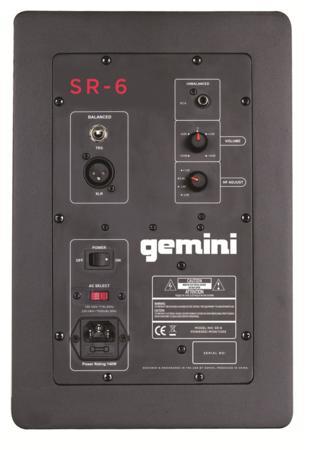The Lowdown
These monitors are at a price point where for a little bit more you can buy competitive models from the likes of Yamaha and KRK to name just two better-known brands. Nonetheless, the Geminis they do hold their own. If you’re looking for audiophile studio reference monitors, they’re not going to be for you, but if you want some decent active speakers to practise DJing on at home, I think they’ll suit you fine.
Video Review
First Impressions / Setting up
Gemini makes no bones about its “affordable” stance. Its products are often appreciably cheaper than the competition, and sometimes offer excellent value – but likewise, sometimes you’d be better spending more for something that performs better (the company’s DJ controllers so far have missed the mark for me, for instance). In order to bring products to market at competitive price points, of course, it’s inevitable that somewhere corners will have to be cut, but at the end of the day to the consumer, what really matters is price, availability and how well the product performs – if marketing is less, for instance, who cares? So we’ll judge them on their merits.
The speakers are reasonably heavy, deep and feel of good quality build. Foam feet that you stick on yourself are provided, and with their red cones and neat, backlit red “Gemini” logo that illuminates on powering up, they look pretty good. They are front ported (a slit at the bottom to assist the bass response, as opposed to at the back) and seem to be made out of some kind of veneered plywood (you can tell by examining the casing where the front port is cut away). Round the back of each speaker are a large-style “kettle” socket (power leads supplied) input, an on off switch, and balanced XLR, balanced TRS and RCA inputs, volume, and a fine-adjust for the treble response.
As these speakers are completely independent of each other, to set them up you run a mono lead from the left output of your mixer or controller to the left speaker, and from right to right.
In Use
To start with, I plugged them in and turned everything up. Close to a computer, there was absolutely no hum or interference, just a very slight white noise hiss on full volume, which is the same with every speaker I’ve ever tested.

I used them with Reloop’s Terminal Mix4 controller (which we’re also currently testing), a controller which is getting big thumbs ups across DJ land for the quality of its sound card, and played a variety of 320kbps MP3s through the speakers, MP3s that I know sound good generally.
The bass is excellent. It’s punchy, clear and filled the room well. Monitors are meant to be listened to “close-field”, ie with them pointing at your head and from not too far away, and in that “sweet spot” they were particualarly good. The treble was a little bright for my ears, but the stepped trim on the back of the speakers is designed to help you adjust this for your particular listening environment. Knocking this down to the lowest-but-one setting took a bit of the high mid/treble harshness away, and I could add back some more refined treble with my mixer control.
The overall sound, while acceptable, didn’t reach the heights of some of the best monitors we’ve reviewed. I suspect nine DJs out of ten will be perfectly happy with what these speakers can do, but if you want top-grade studio sound, they don’t sing like the best.
Conclusion
These monitors are at a price point where for a little bit more you can buy competitive models from the likes of Yamaha and KRK to name just two better-known brands. Nonetheless, the Geminis they do hold their own. If you’re looking for audiophile studio reference monitors, they’re not going to be for you, but if you want some decent active speakers to practise DJing on at home, I think they’ll suit you fine.
They’re in the right ballpark as far as design and features go for most “prosumer” DJs (bi-amped, heavy, front ported, good choice of connectors meaning you can leave several sources plugged in if you wish). If you like the look of them (the red is certainly distinctive) and they’re within your budget, definitely put them on your shortlist for a listen.
At the end of the day, it’s going to come down to price and what’s available where you live. If you happen to see them when you’re looking for monitors, and they’re offered to you at a price that makes sense, they’re a solid buy.




